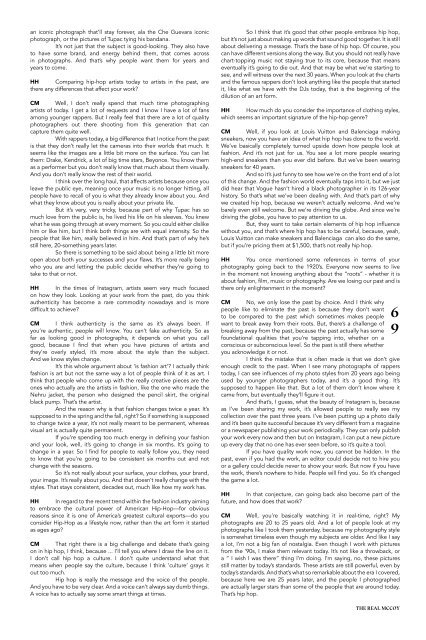Radical Vertical
The magazine is published in collaboration between radicalvertical, Berlin, kulturspace, Los Angeles & LAFFF.
The magazine is published in collaboration between radicalvertical, Berlin, kulturspace, Los Angeles & LAFFF.
You also want an ePaper? Increase the reach of your titles
YUMPU automatically turns print PDFs into web optimized ePapers that Google loves.
an iconic photograph that’ll stay forever, ala the Che Guevara iconic<br />
photograph, or the pictures of Tupac tying his bandana.<br />
It’s not just that the subject is good-looking. They also have<br />
to have some brand, and energy behind them, that comes across<br />
in photographs. And that’s why people want them for years and<br />
years to come.<br />
HH Comparing hip-hop artists today to artists in the past, are<br />
there any differences that affect your work?<br />
CM Well, I don’t really spend that much time photographing<br />
artists of today. I get a lot of requests and I know I have a lot of fans<br />
among younger rappers. But I really feel that there are a lot of quality<br />
photographers out there shooting from this generation that can<br />
capture them quite well.<br />
With rappers today, a big difference that I notice from the past<br />
is that they don’t really let the cameras into their worlds that much. It<br />
seems like the images are a little bit more on the surface. You can list<br />
them: Drake, Kendrick, a lot of big time stars, Beyonce. You know them<br />
as a performer but you don’t really know that much about them visually.<br />
And you don’t really know the rest of their world.<br />
I think over the long haul, that affects artists because once you<br />
leave the public eye, meaning once your music is no longer hitting, all<br />
people have to recall of you is what they already know about you. And<br />
what they know about you is really about your private life.<br />
But it’s very, very tricky, because part of why Tupac has so<br />
much love from the public is, he lived his life on his sleeves. You knew<br />
what he was going through at every moment. So you could either dislike<br />
him or like him, but I think both things are with equal intensity. So the<br />
people that like him, really believed in him. And that’s part of why he’s<br />
still here, 20-something years later.<br />
So there is something to be said about being a little bit more<br />
open about both your successes and your flaws. It’s more really being<br />
who you are and letting the public decide whether they’re going to<br />
take to that or not.<br />
HH In the times of Instagram, artists seem very much focused<br />
on how they look. Looking at your work from the past, do you think<br />
authenticity has become a rare commodity nowadays and is more<br />
difficult to achieve?<br />
CM I think authenticity is the same as it’s always been. If<br />
you’re authentic, people will know. You can’t fake authenticity. So as<br />
far as looking good in photographs, it depends on what you call<br />
good, because I find that when you have pictures of artists and<br />
they’re overly styled, it’s more about the style than the subject.<br />
And we know styles change.<br />
It’s this whole argument about ‘is fashion art’? I actually think<br />
fashion is art but not the same way a lot of people think of it as art. I<br />
think that people who come up with the really creative pieces are the<br />
ones who actually are the artists in fashion, like the one who made the<br />
Nehru jacket, the person who designed the pencil skirt, the original<br />
black pump. That’s the artist.<br />
And the reason why is that fashion changes twice a year. It’s<br />
supposed to in the spring and the fall, right? So if something is supposed<br />
to change twice a year, it’s not really meant to be permanent, whereas<br />
visual art is actually quite permanent.<br />
If you’re spending too much energy in defining your fashion<br />
and your look, well, it’s going to change in six months. It’s going to<br />
change in a year. So I find for people to really follow you, they need<br />
to know that you’re going to be consistent six months out and not<br />
change with the seasons.<br />
So it’s not really about your surface, your clothes, your brand,<br />
your image. It’s really about you. And that doesn’t really change with the<br />
styles. That stays consistent, decades out, much like how my work has.<br />
HH In regard to the recent trend within the fashion industry aiming<br />
to embrace the cultural power of American Hip-Hop—for obvious<br />
reasons since it is one of America’s greatest cultural exports—do you<br />
consider Hip-Hop as a lifestyle now, rather than the art form it started<br />
as ages ago?<br />
CM That right there is a big challenge and debate that’s going<br />
on in hip hop, I think, because ... I’ll tell you where I draw the line on it.<br />
I don’t call hip hop a culture. I don’t quite understand what that<br />
means when people say the culture, because I think ‘culture’ grays it<br />
out too much.<br />
Hip hop is really the message and the voice of the people.<br />
And you have to be very clear. And a voice can’t always say dumb things.<br />
A voice has to actually say some smart things at times.<br />
So I think that it’s good that other people embrace hip hop,<br />
but it’s not just about making up words that sound good together. It is still<br />
about delivering a message. That’s the base of hip hop. Of course, you<br />
can have different versions along the way. But you should not really have<br />
chart-topping music not staying true to its core, because that means<br />
eventually it’s going to die out. And that may be what we’re starting to<br />
see, and will witness over the next 30 years. When you look at the charts<br />
and the famous rappers don’t look anything like the people that started<br />
it, like what we have with the DJs today, that is the beginning of the<br />
dilution of an art form.<br />
HH How much do you consider the importance of clothing styles,<br />
which seems an important signature of the hip-hop genre?<br />
CM Well, if you look at Louis Vuitton and Balenciaga making<br />
sneakers, now you have an idea of what hip hop has done to the world.<br />
We’ve basically completely turned upside down how people look at<br />
fashion. And it’s not just for us. You see a lot more people wearing<br />
high-end sneakers than you ever did before. But we’ve been wearing<br />
sneakers for 40 years.<br />
And so it’s just funny to see how we’re on the front end of a lot<br />
of this change. And the fashion world eventually taps into it, but we just<br />
did hear that Vogue hasn’t hired a black photographer in its 126-year<br />
history. So that’s what we’ve been dealing with. And that’s part of why<br />
we created hip hop, because we weren’t actually welcome. And we’re<br />
barely even still welcome. But we’re driving the globe. And since we’re<br />
driving the globe, you have to pay attention to us.<br />
But, they want to take certain elements of hip hop influence<br />
without you, and that’s where hip hop has to be careful, because, yeah,<br />
Louis Vuitton can make sneakers and Balenciaga can also do the same,<br />
but if you’re pricing them at $1,500, that’s not really hip hop.<br />
HH You once mentioned some references in terms of your<br />
photography going back to the 1920’s. Everyone now seems to live<br />
in the moment not knowing anything about the “roots” - whether it is<br />
about fashion, film, music or photography. Are we losing our past and is<br />
there only enlightenment in the moment?<br />
CM No, we only lose the past by choice. And I think why<br />
people like to eliminate the past is because they don’t want<br />
to be compared to the past which sometimes makes people<br />
want to break away from their roots. But, there’s a challenge of<br />
breaking away from the past, because the past actually has some<br />
foundational qualities that you’re tapping into, whether on a<br />
conscious or subconscious level. So the past is still there whether<br />
you acknowledge it or not.<br />
I think the mistake that is often made is that we don’t give<br />
enough credit to the past. When I see many photographs of rappers<br />
today, I can see influences of my photo styles from 20 years ago being<br />
used by younger photographers today, and it’s a good thing. It’s<br />
supposed to happen like that. But a lot of them don’t know where it<br />
came from, but eventually they’ll figure it out.<br />
And that’s, I guess, what the beauty of Instagram is, because<br />
as I’ve been sharing my work, it’s allowed people to really see my<br />
collection over the past three years. I’ve been putting up a photo daily<br />
and it’s been quite successful because it’s very different from a magazine<br />
or a newspaper publishing your work periodically. They can only publish<br />
your work every now and then but on Instagram, I can put a new picture<br />
up every day that no one has ever seen before, so it’s quite a tool.<br />
If you have quality work now, you cannot be hidden. In the<br />
past, even if you had the work, an editor could decide not to hire you<br />
or a gallery could decide never to show your work. But now if you have<br />
the work, there’s nowhere to hide. People will find you. So it’s changed<br />
the game a lot.<br />
HH In that conjecture, can going back also become part of the<br />
future, and how does that work?<br />
CM Well, you’re basically watching it in real-time, right? My<br />
photographs are 20 to 25 years old. And a lot of people look at my<br />
photographs like I took them yesterday, because my photography style<br />
is somewhat timeless even though my subjects are older. And like I say<br />
a lot, I’m not a big fan of nostalgia. Even though I work with pictures<br />
from the ‘90s, I make them relevant today. It’s not like a throwback, or<br />
a “ I wish I was there” thing I’m doing. I’m saying, no, these pictures<br />
still matter by today’s standards. These artists are still powerful, even by<br />
today’s standards. And that’s what so remarkable about the era I covered,<br />
because here we are 25 years later, and the people I photographed<br />
are actually larger stars than some of the people that are around today.<br />
That’s hip hop.<br />
6<br />
9<br />
THE REAL MCCOY





